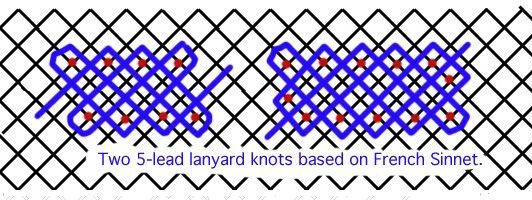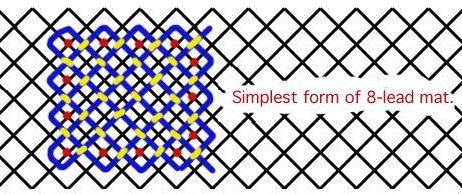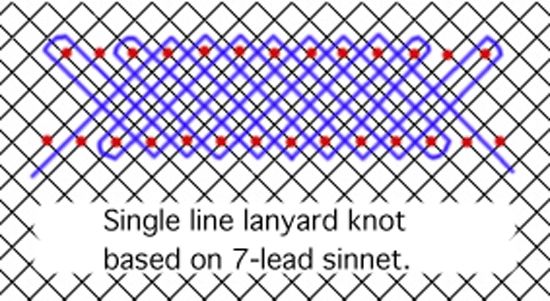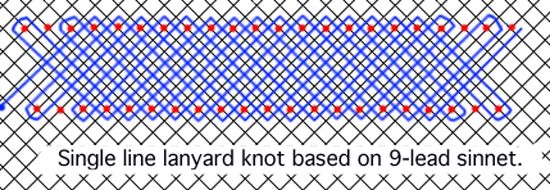|
A request came in for some advice on creating a pattern for the lanyard knot based on five-strand French sinnet, and so here is a sketch which may make things a bit clearer. Note that I draw my patterns on a bias, on graph paper. (Well, I would if I were using a pencil and paper, but I created virtual graph paper for this demonstration...) The knot goes between the lines, and turns around the intersections, so it should be easy enough to follow.
|
|
I didn't mark the crossings to show which ones are on top, because that's trivial after you've filled in the pattern. Just go to the first place where your line crosses itself and mark that one with a heavy mark in the direction the top goes, then fill in the rest of the marks in a checkerboard pattern. Every other crossing is the same, opposites in between, just like any over-and-under weave.
|

|
Notice the little arrows -- they illustrate the direction the line is passing around the end pegs.
|
|
|
You can try this pattern with any number of pegs, but it will become obvious fairly quickly if you choose incorrectly. You can also change the way the loose ends come out, as you can see in the next picture.
|

|
|
It's up to you which way you want to begin, but that choice restricts the rest of the pattern. The best way to do it is to arbitrarily lay out more space on the grid than you're going to use, draw the pattern out to the length you want before making the line come back on itself, and see if it works. Be prepared to start over if it doesn't work, and just turn the path the other way at the end, left instead of right, or vice versa.
|
|
|
While I'm at it, here is a pattern for eight leads, a very Celtic looking knot, which I just found in a pamphlet given me by Brian E. Field a few years ago at a meeting of the International Guild of Knot Tyers. It can also be increased in length.
|

|
|
Red dots are pegs, yellow highlights mark the direction of the top strand.
|
|
For the sake of completeness, here is a shot of how to do the seven-lead variation of the single-line lanyard knot based on French sinnet, above. This pattern cost me two days and nearly half a pad of quadralinear graph paper to work out.
|

|
|
I couldn't resist, and went ahead to figure out the pattern for a nine-lead, also. It's likely that there are different patterns for the seven-lead and the nine-lead, just as I showed two different ones for the five-lead, but so far I'm not sure what they'll look like.
|

|
|
|